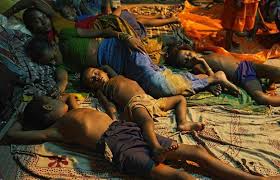 Bloomberg has been running a series of sensational exposes on the rampant spread of TB and numerous other infectious diseases in India due to an abhorrent lack of basic sanitation.
Bloomberg has been running a series of sensational exposes on the rampant spread of TB and numerous other infectious diseases in India due to an abhorrent lack of basic sanitation.
Last month the news organization highlighted the high level of pollution in the Ganges, a river considered holy by Indians and frequently used by pilgrims to “wash away their sins.”
The Ganges is no ordinary river. It originates pristine from a Himalayan glacier 3,048 meters (10,000 feet) high, worshiped as a goddess, reverently called mother. Yet raw sewage from 29 cities blights its 2,525-kilometer (1,570-mile) route as bloated bodies of dead animals, funeral pyre ashes, reduced flow from dams and factory waste fouls its waters.

“If we don’t clean this river now, we’re risking a huge public health crisis,” said Somnath Bandyopadhyay, former consultant to the Indian environment ministry’s National Ganga River Basin Authority.
“From pathogens to endocrine disruptors, the water is deteriorating faster than we can understand,” Bandyopadhyay said. “At places like Varanasi, we are taking a holy dip in the sewage of various upstream cities.”
Water samples tested in a lab by the “Clean Ganga Campaign” showed fecal coliform as high as 1.5 million counts per 100 milliliters at the confluence of the Ganges and Varuna River, named after the god of water.
The tolerable limit for bathing is less than 500 of the bacteria that can cause such diseases as typhoid, dysentery and cholera, said Mishra, a Banaras Hindu University professor and among those Modi met before he announced his Ganga plan.
In India, 53 percent of the people have no access to a basic toilet and defecation along water bodies is common. At least 37.7 million a year are affected by water-borne diseases that costs up to $600 million to treat, according to WaterAid.
Following up the story about the disaster that is the Ganges, Bloomberg followed up this week with a detailed story about how half of India population or about 600 million people don’t have toilets and wind up defecating wherever they happen to be when the urge arises. Unwary and even cautious tourists to India face a very real threat of death from drug resistant fecal infections.
The economy suffers from premature deaths, higher health care costs and a drop in productivity as people fall ill and miss time from work and school, according to a 2011 report by the Water and Sanitation Program, a World Bank-supported group that analyzed data from 2006, the most recent available. A lack of toilets also deters tourists, with at least three studies showing India poses the highest risk to travelers of picking up multiple drug-resistant strains of fecal bacteria.
At stake is $54 billion a year in economic costs in India, equivalent to about 3 percent of gross domestic product in Asia’s third-biggest economy and a quarter of global losses from poor sanitation. Open defecation contaminates ground water, spreads disease and exposes women to sexual assaults, including two girls in India who were raped and hanged from a tree last month after squatting in a field near their homes.
India accounts for about 60 percent of the world’s residents without toilets, according to a World Health Organization and UNICEF report released in May. The country’s 50 percent open defecation rate compares with 23 percent in Pakistan, 3 percent in Bangladesh and 1 percent in China, the report said.
Convincing rural Indians to use toilets may prove a bigger challenge than building them, Rosenboom said. After centuries of practicing open defecation, some families refuse to end the cultural norm because using a toilet is sometimes associated with filth and low social status.
“Open defecation cannot end on the planet without it ending in India first,” Rosenboom said in New Delhi. “Beyond just toilets, India needs to tell its people that this behavior is not acceptable and is damaging to society.”
If you love to travel and are considering taking a trip to India, you may want to change your plans or take extraordinary measures to protect your health when there.
Speak Your Mind